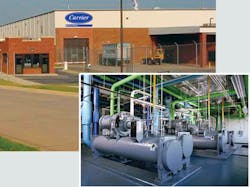Not Going Green? You’re Losing Profits and Clients
Green is much more than an environmental imperative or social responsibility cause – it’s an essential strategy for savvy businesses looking to differentiate and grow the bottom line. And it’s important to every aspect of business, starting with manufacturing.
Green products need to start with a green company, which makes sustainable manufacturing facilities key. According to the U.S. Green Building Council, there are 738 LEED-certified industrial manufacturing facilities worldwide and another 1,335 facilities seeking certification. The market growth has been exponential: 375% in the last four years.
The rise in green facilities for large multinational companies (at United Technologies we just earned our 17th LEED-certified facility) is aligned with the larger green building market trend – 47% of all new commercial construction is green building construction, compared to only 2% in 2005.
Recent research suggests there are several factors for this increased focus on green, including client demand and public opinion on sustainable products and buildings. But it is important to recognize that the opportunities go beyond perceptions. Green building is a smart investment strategy. Here’s why.
Forty percent of the energy we consume in the United States is used to operate our buildings. In fact, according to a 2013 report by the Rhodium Group, we spend an estimated $432 billion each year to power our homes, stores and offices – nearly as much as the private sector spends on health insurance.
We have the technology available today to improve the energy-efficiency of buildings by 30%. Doing so would have an internal rate of return of 28.6% over a 10-year period – that’s four times better than average corporate bond yields and double the returns seen by high-performing venture capital firms. Most green building options cost the same or only slightly higher than conventional alternatives, yet they deliver significant energy savings. For instance, new green buildings decrease operating costs by 8% over one year, and 15% over 5 years. Over time, the argument that green is more expensive becomes invalid.
The potential for savings is even more critical when you consider the fact that the cost of energy is increasing and our global demand is becoming insatiable. The International Energy Agency predicts that energy prices will rise by a further 17% over the next two decades. Improving how energy is consumed will not only provide immediate cost savings but will also help to safe-guard against energy price hikes.
So, if green building is such a profitable business strategy, why isn’t it the norm?
There are market and regulatory barriers at play that are impacting the green building movement, but the most pressing is the lack of good, readily available information. Many still believe that green building options are more expensive than traditional options. And business executives are generally unable to compare the energy costs of different facilities when shopping for new floor space.
However, progress is being made. The long-term business value of going green is being recognized by the government and within the private sector. For instance, the Environmental Protection Agency has expanded its Energy Star program to the building sector, which gives executives the tools they need to improve efficiency of new and existing facilities. In 2010, more than 160,000 buildings took advantage of the program and saved $7.1 billion on energy expenses. The U.S. Green Building Council’s voluntary Leadership in Energy & Environmental Design (LEED®) program is another initiative that is advancing the green building movement, with more than 21,000 certified commercial and institutional projects representing 3 billion square feet of construction space globally. The Council has also developed the LEED Alternative Compliance Paths (ACPs) to help address the unique energy needs and uses of manufacturing facilities.
Smart policy will help further drive investment in energy efficiency. Improved building labels and codes, financial incentives and regulatory reform are just some of the factors that will help accelerate the green market.
It’s an opportunity that businesses simply can’t afford to ignore.
John Mandyck is chief sustainability officer for UTC Building & Industrial Systems, a unit of United Technologies Corp., a leading provider to the aerospace and building systems industries worldwide. Mandyck chairs the Corporate Advisory Board of the World Green Building Council and serves as chairman of the Board of Directors for the Urban Green Council in New York City.

